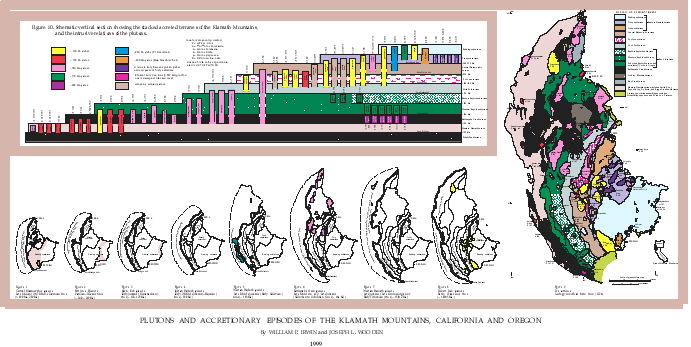 Abstract Abstract
The Klamath Mountains consist of various accreted terranes and include many plutons that range in composition from gabbro to granodiorite. Some of the plutons (preaccretionary plutons) were parts of terranes before the terranes accreted; others (accretionary plutons) intruded during or after the accretion of their host terrane(s). This report attempts to (1) graphically illustrate how the Klamath Mountains grew by the accretion of allochthonous oceanic terranes during early Paleozoic to Cretaceous times, (2) identify the plutons as either preaccretionary or accretionary, and (3) genetically relate the plutonic intrusions to specific accretionary episodes.
The eight accretionary episodes portrayed in this report are similar to those shown by Irwin and Mankinen (1998) who briefly described the basis for the timing of the episodes and who illustrated the ~110 degrees of clockwise rotation of the Klamath Mountains since Early Devonian time. Each episode is named for the accreting terrane. In all episodes (Figs. 1-8), the heavy black line represents a fault that separates the accreting oceanic rocks on the left from earlier accreted terranes on the right. The preaccretionary plutons are shown within the accreting oceanic crustal rocks to the left of the heavy black line, and the accretionary plutons in most instances are shown intruding previously accreted terranes to the right. Episodes earlier than the Central Metamorphic episode (Fig. 1), and that may have been important in the formation of the early Paleozoic nucleous of the province (the Eastern Klamath terrane), are not known. The "Present Time" distribution of the accreted terranes and plutons is shown at a large scale in Figure 9.
The schematic vertical section (Fig. 10) depicts the terranes as a stack of horizontal slabs that include or are intruded by vertical plutons. Note that at their base the ~170 Ma preaccretionary plutons of the Western Hayfork subterrane are truncated by the ~164 Ma Salt Creek accretionary fault, the ~160 Ma accretionary plutons are truncated by the ~150 Ma Bear Wallow accretionary fault, and the ~150 Ma accretionary plutons (and questionably the Grants Pass ~139 Ma accretionary pluton) are truncated by the ~120 Ma South Fork fault.
|
First posted August 19, 1999
Part or all of this report is presented in Portable Document Format (PDF). For best results viewing and printing PDF documents, it is recommended that you download the documents to your computer and open them with Adobe Reader. PDF documents opened from your browser may not display or print as intended. Download the latest version of Adobe Reader, free of charge.
|